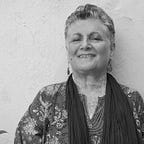Whereabouts
Whereabouts by Jhumpa Lahiri: A Book Review
On the cover page of the Kindle edition is what appears to be a scene from a gallery. A stuffed pink satin couch with a rope across (so no one should sit on it) and above it an oval shaped picture/artwork of a pink and blue sky with birds. On closer examination, by zooming into it on my Kindle screen, it's an alcove that the picture and couch are inserted in. Just like in a gallery.
While the book is called a novel, all 123 pages of it, it’s not a novel as I know novels, but a series of vignettes, forty-six in all, sometimes connected to each other and sometimes, not. I like that and the length of each vignette, so I don’t have to scramble to remember the characters that go in and out. There are no names — of towns, streets, or people — so no memory required here.
But I know it is Italy, as I know about Lahiri’s experiments with living in Italy and writing and translating between English and Italian. Her previous book ‘In Other Words’, which she wrote originally in Italian and was translated, not by her, was about her immersion into the Italian language and writing in it. In ‘Whereabouts’ she wrote the original in Italian and translated it herself.
I lived in Rome, Italy for five years in the late 1980s. And while Lahiri doesn’t reveal the name of the town she is writing from or about, it doesn’t matter. The cobbled streets, the bars, the coffees, are all familiar, embedded in my memory. I like the fact that she writes in first person, as I too, somewhat of a writer, like this style. Other styles elude me. I like her short sentences and I can picture the scenes she describes, the moods she exhales. I like her detail, just the right amount.
Solitude: it’s become my trade. As it requires a certain discipline, it’s a condition I try to perfect. And yet it plagues me, it weighs on me in spite of my knowing it so well.
Much of the book is about a life of solitude. It could also have been titled Solitude. A single woman, living by herself, with occasional contact with neighbours, friends, colleagues, and students. These relationships and situations are revealed in fleeting instances, in a distant way.
In some ways, that is also the charm of the book. Its almost as if you’re there with the writer, walking side by side with her, and then you’re not. Just as she invites you into her head, she shuts down. Maybe you don’t need to know any more. Maybe there isn’t any more. Maybe.
In her visits to the salon, her therapist, the library, the museum, the supermarket, walks in the piazza, in the café, she is watching, listening, and describing what she sees. She often envies the carefree and uninhibited lives of others, reflecting on her difficult childhood with a father, the only earning member in the family, who loved only the theatre and her mother who held on, tightly, to her purse strings. A somewhat suffocating childhood.
And then, towards the end of the book, she is offered a yearlong fellowship with other scholars. She is looking forward to the meals she would not have to cook and the ready-made companions at the dinner table. She oscillates between solitude and company.
“I’ve always felt in someone’s shadow, even though I don’t have to compare myself to brothers who are smarter or sisters who are prettier. There is no escape from the shadows that mount, inexorably, in the darkening season. Nor can we escape the shadows our families cast. That said, there are times I miss the pleasant shade a companion might provide.”
It is in the shade and shadows that we find ourselves. Maybe.
Published by Penguin, 2021.
